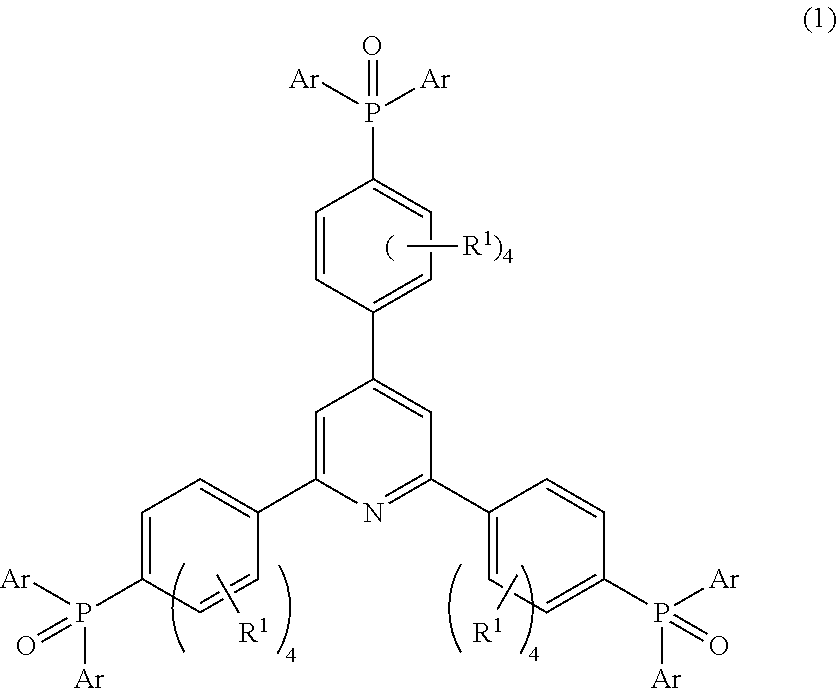Phosphine oxide compound, organic electroluminescence element, production method and uses thereof
a technology of phosphine oxide and organic electroluminescence elements, applied in the field can solve the problems of low yield insufficient deposition stability inability to meet the requirements of phosphine oxide compounds, etc., to achieve excellent electric power efficiency, stable decomposition rate, and stable production
- Summary
- Abstract
- Description
- Claims
- Application Information
AI Technical Summary
Benefits of technology
Problems solved by technology
Method used
Image
Examples
example 1
[0113]Example 1 is described with reference to the following schemata.
(i) Synthesis of 2,4,6-tris(4-bromophenyl)pyridine (a-1)
[0114]To a round-bottom flask, 4.74 g (25.6 mmol) of 4-bromobenzaldehyde, 10.2 g (51.2 mmol) of 4-bromoacetophenone, 39.5 g (512 mmol) of ammonium acetate and 45 ml of acetic acid were introduced and stirred at 150° C. for 4 hours and then cooled to room temperature. Thereafter, 50 ml of water was added to the mixture and stirred for 1 hour. The mixture was filtered off and the resulting yellow solid was dissolved in chloroform. Then, the solvent was distilled off under reduced pressure to prepare an oily substance. To the oily substance, 40 ml of ethanol was added and stirred for 30 min while refluxing. The temperature of the mixture was returned to room temperature and the mixture was filtered off to prepare a white solid. This white solid was identified as 2,4,6-tris(4-bromophenyl)pyridine by 1H-NMR and mass spectrometry. The amount (yield) was 5.36 g (39%...
example 2
[0119]Example 2 is described with reference to the following schemata.
(i) Synthesis of 2,4,6-tris(3,5-dimethyl-4-bromophenyl)pyridine (b-1)
[0120]To a round-bottom flask, 4.30 g (20.2 mmol) of 3,5-dimethyl-4-bromobenzaldehyde, 9.17 g (40.4 mmol) of 3,5-dimethyl-4-bromoacetophenone, 31.1 g (404 mmol) of ammonium acetate and 40 ml of acetic acid were introduced and stirred at 150° C. for 4 hours and then cooled to room temperature. Thereafter, 50 ml of water was added to the mixture and stirred for 1 hour. The mixture was filtered off and the resulting yellow solid was dissolved in chloroform. Then, the solvent was distilled off under reduced pressure to prepare an oily substance. To the oily substance, 40 ml of ethanol was added and stirred for 30 min while refluxing. The temperature of the mixture was returned to room temperature and the mixture was filtered off to prepare a white solid. This white solid was identified as 2,4,6-tris-(3,5-dimethyl-4-bromophenyl)pyridine by 1H-NMR and ...
example 3
[0124]Example 3 is described with reference to the following schemata.
(i) Synthesis of 2,4,6-tris(3-butyl-4-bromophenyl)pyridine (c-1)
[0125]To a round-bottom flask, 6.07 g (25.2 mmol) of 3-butyl-4-bromobenzaldehyde, 12.9 g (50.4 mmol) of 3-butyl-4-bromoacetophenone, 38.8 g (504 mmol) of ammonium acetate and 45 ml of acetic acid were introduced and stirred at 150° C. for 4 hours and then cooled to room temperature. Thereafter, 50 ml of water was added to the mixture and stirred for 1 hour. The mixture was filtered off and the resulting yellow solid was dissolved in chloroform. After the solvent was distilled off under reduced pressure, an oily substance was prepared. To the oily substance, 40 ml of ethanol was added and stirred for 30 min while refluxing. The temperature of the mixture was returned to room temperature and the mixture was filtered off to prepare a white solid. This white solid was identified as 2,4,6-tris-(3-butyl-4-bromophenyl)pyridine by 1H-NMR and mass spectrometry...
PUM
| Property | Measurement | Unit |
|---|---|---|
| thickness | aaaaa | aaaaa |
| width | aaaaa | aaaaa |
| distance | aaaaa | aaaaa |
Abstract
Description
Claims
Application Information
 Login to View More
Login to View More - R&D
- Intellectual Property
- Life Sciences
- Materials
- Tech Scout
- Unparalleled Data Quality
- Higher Quality Content
- 60% Fewer Hallucinations
Browse by: Latest US Patents, China's latest patents, Technical Efficacy Thesaurus, Application Domain, Technology Topic, Popular Technical Reports.
© 2025 PatSnap. All rights reserved.Legal|Privacy policy|Modern Slavery Act Transparency Statement|Sitemap|About US| Contact US: help@patsnap.com



